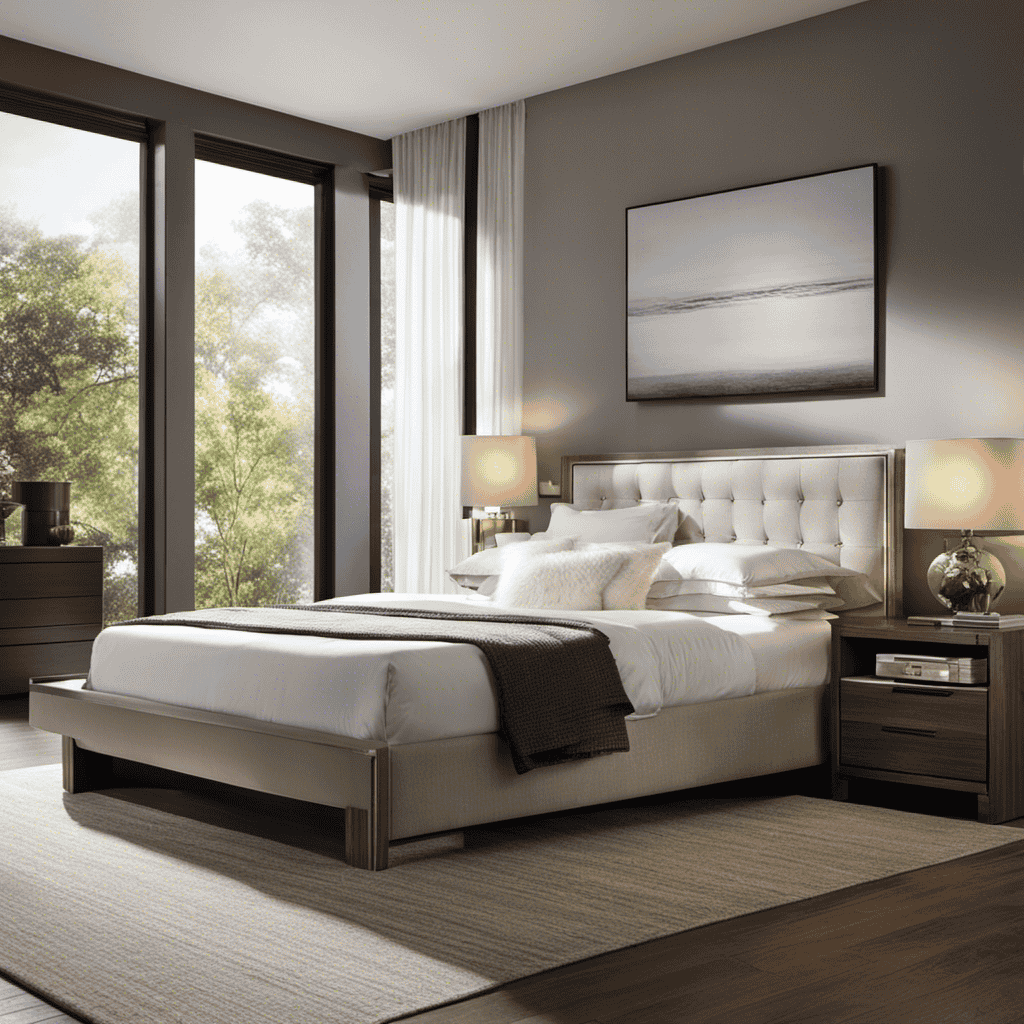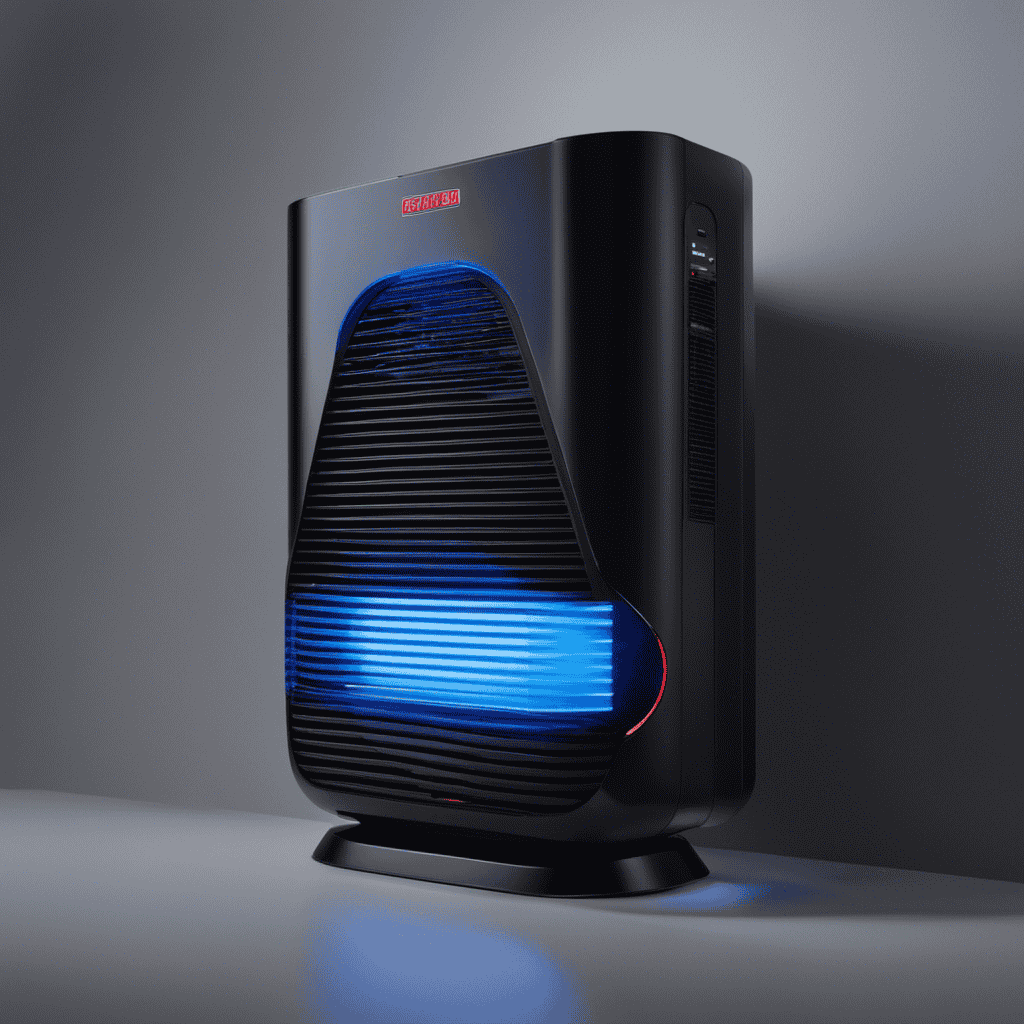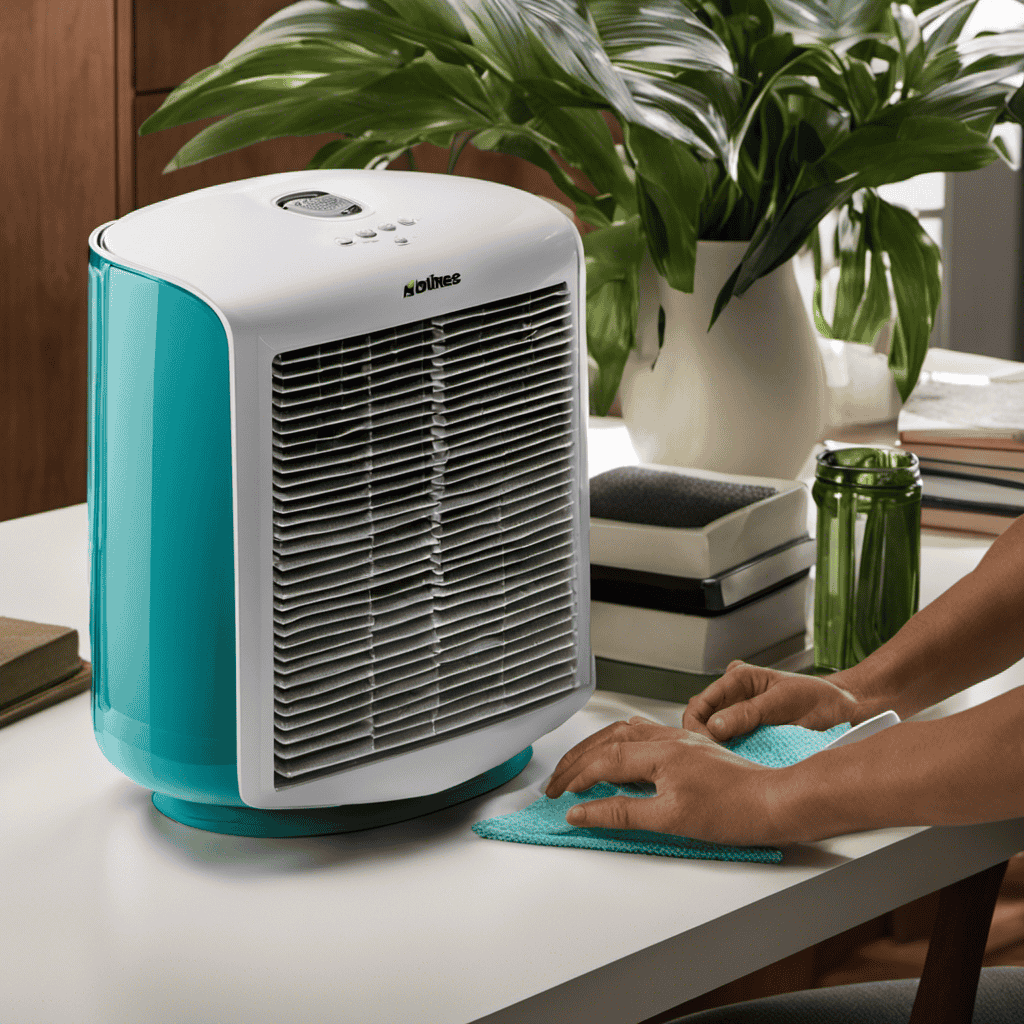As someone who specializes in air quality, I can confidently state that 90% of individuals do not fully understand the significance of the ‘bad air’ warning on their air purifier.
In this article, I will shed light on the types of air pollutants that can contaminate your home, the common signs of poor air quality, and how to interpret air purifier readings.
By understanding the factors that affect air purifier performance, troubleshooting bad air warnings, and implementing tips for improving indoor air quality, you can breathe easy knowing your home is a haven of fresh, clean air.
Key Takeaways
- Poor air quality can lead to respiratory problems, cardiovascular diseases, and worsened respiratory conditions.
- Indoor air pollutants can come from sources such as vehicle emissions, industrial activities, tobacco smoke, household cleaning products, and building materials.
- Factors affecting air purifier performance include room size, air quality in the environment, and regular filter maintenance.
- To improve indoor air quality, it is important to maintain optimal humidity levels, reduce the presence of pollutants, and ensure adequate ventilation. Regular cleaning of surfaces and proper air purifier maintenance are also crucial.
Types of Air Pollutants
You might be wondering what types of air pollutants are commonly found in the air. Well, there are several outdoor pollutants that contribute to air pollution. These include particulate matter, such as dust and pollen, as well as gases like nitrogen dioxide and sulfur dioxide. These pollutants come from a variety of sources, including vehicle emissions, industrial activities, and power plants.
In addition to outdoor pollutants, there are also sources of indoor pollution that can affect the air quality inside our homes and buildings. These sources include tobacco smoke, household cleaning products, and building materials that release volatile organic compounds (VOCs). Indoor pollution can also be caused by inadequate ventilation, which can result in the accumulation of pollutants.
Understanding the different types of air pollutants is important in order to take steps to minimize our exposure and protect our health.
Common Signs of Poor Air Quality
As I delve into the topic of health effects of pollution and factors affecting indoor air quality, it is crucial to understand the impact that pollution can have on our overall well-being.
Pollution, both outdoor and indoor, is known to contribute to various health issues, ranging from respiratory problems to cardiovascular diseases.
Furthermore, there are several factors that influence the quality of indoor air, such as the presence of volatile organic compounds (VOCs), inadequate ventilation, and the use of certain household products.
Health Effects of Pollution
When an air purifier says ‘bad air,’ it means that the air you are breathing in contains pollutants that can negatively impact your health. These pollutants pose various health risks and can lead to respiratory problems.
Breathing in polluted air can irritate the respiratory system, causing symptoms such as coughing, wheezing, and shortness of breath. Long-term exposure to pollutants in the air can also increase the risk of developing chronic respiratory diseases like asthma and bronchitis.
Additionally, pollutants in the air can trigger allergies and worsen existing respiratory conditions. It is important to be aware of the air quality around you and take steps to improve it, such as using air purifiers and minimizing exposure to outdoor pollutants.
Indoor Air Quality Factors
To improve indoor air quality, it’s important to consider factors such as ventilation, humidity levels, and the presence of pollutants. These factors can significantly impact the air we breathe and our overall health.
Here are four key factors to consider when evaluating indoor air quality:
-
Ventilation: Proper ventilation helps to remove stale air and bring in fresh air from outdoors. It dilutes indoor pollutants and improves air circulation, reducing the risk of respiratory issues.
-
Humidity levels: Maintaining optimal humidity levels between 30% and 50% can prevent the growth of mold, bacteria, and dust mites. High humidity can promote the growth of these allergens, while low humidity can cause dryness and irritation.
-
Presence of pollutants: Identifying and reducing the presence of pollutants such as volatile organic compounds (VOCs), dust, pet dander, and tobacco smoke is crucial. These pollutants can worsen allergies, trigger asthma attacks, and contribute to long-term health problems.
-
Air pollution sources: Understanding the sources of indoor air pollution, such as cleaning products, paint, and furniture, can help in minimizing their impact on air quality.
By considering these factors, we can create a healthier indoor environment.
Now, let’s delve into understanding air purifier readings and how they can help in maintaining good indoor air quality.
Understanding Air Purifier Readings
Accurate air quality readings are essential for understanding the state of our indoor environment. By interpreting air purifier data, we can gain valuable insights into the pollutants present and the effectiveness of our air purifiers.
Improving indoor air quality is a crucial step in creating a healthy and safe living space for ourselves and our loved ones.
Accurate Air Quality Readings
The air purifier’s readings aren’t always accurate. While they provide valuable information about the air quality in our surroundings, it is important to understand their limitations. Here are four factors that can affect the accuracy of air quality readings:
-
Sensor calibration: Over time, the sensors in air purifiers may become less accurate due to wear and tear. Regular calibration is necessary to ensure reliable readings.
-
Placement of the purifier: The location of the air purifier can greatly impact the readings. Placing it near a source of pollution, such as a window or a kitchen, can result in higher readings even if the overall air quality is good.
-
Interference from other devices: Electronic devices emitting electromagnetic radiation can interfere with air purifier sensors, leading to inaccurate readings.
-
Sensitivity to specific pollutants: Air purifiers may be more sensitive to certain pollutants than others. This can result in skewed readings if the purifier is primarily designed to detect specific pollutants.
Interpreting Air Purifier Data
When interpreting air purifier data, I take into account factors like sensor calibration, placement, interference, and sensitivity to specific pollutants.
Sensor calibration ensures accurate readings by adjusting the sensor’s response to match known pollutant concentrations.
Proper placement is crucial as the air purifier should be located where it can effectively sample the air and avoid any obstruction.
Interference can occur from nearby sources such as electronics or other air purifiers, leading to inaccurate readings.
Additionally, air purifiers may have different sensitivities to specific pollutants, so understanding the purifier’s capabilities is important for accurate interpretation.
Regular air purifier maintenance, including cleaning filters and checking for any damage, is also crucial to ensure reliable data.
Improving Indoor Air Quality
Improving indoor air quality can be achieved by implementing simple measures such as opening windows, using natural ventilation, and regularly cleaning surfaces. These measures can help to reduce the concentration of pollutants in the air and create a healthier living environment.
Additionally, regular air purifier maintenance is crucial for optimal performance and effectiveness. Here are four key benefits of clean air and the importance of air purifier maintenance:
-
Health benefits: Clean air can reduce the risk of respiratory problems, allergies, and other health issues caused by indoor air pollution.
-
Improved sleep: Breathing clean air can promote better sleep quality, leading to improved overall well-being.
-
Increased productivity: Clean air can enhance productivity and concentration, making it easier to focus and perform tasks efficiently.
-
Odor control: A clean air environment helps to eliminate unpleasant odors and create a fresher living space.
Regular air purifier maintenance ensures that the purifier continues to effectively remove pollutants from the air, providing these benefits and maintaining good indoor air quality.
Factors Affecting Air Purifier Performance
To optimize the performance of your air purifier, consider factors such as room size, air quality, and filter maintenance. The efficiency of an air purifier can be affected by these factors.
Firstly, the size of the room plays a crucial role. A larger room would require a higher airflow rate to effectively clean the air.
Secondly, the air quality in your environment also impacts the purifier’s performance. If you live in an area with high pollution levels, you may need a purifier with a stronger filtration system.
Lastly, regular filter maintenance is essential to keep the purifier operating efficiently. Clogged filters can reduce the purifier’s effectiveness.
It is also important to note the benefits of air purifiers, such as removing allergens, dust, and odors, improving indoor air quality, and promoting a healthier living environment.
Troubleshooting Bad Air Warnings
If you’re experiencing warnings or alarms from your air purifier, check the user manual for troubleshooting tips. Here are some common troubleshooting steps you can take to address the issue:
-
Check the filters: Dirty or clogged filters can cause the air purifier to give bad air warnings. Clean or replace the filters as recommended by the manufacturer.
-
Check the airflow: Make sure there are no obstructions blocking the airflow into or out of the purifier. Clear any debris or objects that may be blocking the vents.
-
Reset the unit: Sometimes, a simple reset can resolve the issue. Turn off the purifier, unplug it from the power source, wait for a few minutes, and then plug it back in.
-
Contact customer support: If the above steps don’t solve the problem, reach out to the manufacturer’s customer support for further assistance.
Tips for Improving Indoor Air Quality
Make sure you regularly clean or replace the filters in your air purifier to ensure good indoor air quality. This is essential for the prevention of respiratory illnesses. Dust, pollen, pet dander, and other airborne particles can accumulate in the filters over time, reducing their efficiency.
By keeping the filters clean, you can effectively remove these pollutants from the air, providing a healthier environment for you and your family.
Additionally, there are natural ways to purify the air in your home. Opening windows to allow for fresh air circulation, using indoor plants that are known for their air-purifying properties, and keeping a clean and clutter-free space can all contribute to improved indoor air quality.
Taking these steps can help prevent respiratory illnesses and create a healthier living environment.
Frequently Asked Questions
How Often Should I Replace the Filters in My Air Purifier?
I replace the filters in my air purifier every 6-12 months, depending on usage. Signs that indicate the filters need to be replaced include reduced airflow, increased dust or odors, and the filter indicator light turning on.
Can an Air Purifier Completely Eliminate All Air Pollutants?
An air purifier’s "bad air" alert likely means that the air quality is poor, possibly due to high levels of pollutants. Air purifiers can help reduce some outdoor pollutants, but not all. However, they can increase energy consumption.
Are There Any Specific Air Purifier Models That Are More Effective at Removing Certain Types of Pollutants?
Certain air purifier models can be more effective at removing specific types of pollutants. It is important to consider the Clean Air Delivery Rate (CADR) and the type of filtration system used to target different pollutants such as dust, pollen, smoke, or pet dander.
Can an Air Purifier Help With Allergies or Respiratory Conditions?
An air purifier can greatly improve allergies and respiratory conditions. It filters out allergens and pollutants, creating cleaner air to breathe. Regular maintenance is crucial to ensure optimal performance and reap the full benefits.
Is It Necessary to Run an Air Purifier All Day, or Can It Be Turned off at Certain Times?
It is not necessary to run an air purifier all day. Nighttime use can be sufficient. However, turning it off at certain times may decrease its effectiveness. Consider energy consumption when deciding on usage.
Is Allergan in the Air a Sign of Bad Air Quality in My Home?
If you are noticing allergan in the air, it could be a sign of poor air quality in your home. Consider investing in an allergan air purifier to help eliminate harmful particles and allergens from your indoor environment, creating a healthier and cleaner living space for you and your family.
Conclusion
In conclusion, it is crucial to understand the meaning behind a bad air warning on an air purifier for maintaining a healthy indoor environment. By familiarizing ourselves with the types of air pollutants and common signs of poor air quality, we can better interpret air purifier readings.
Factors such as filter quality, room size, and maintenance also play a role in the performance of air purifiers. It is important to consider these factors when choosing and using an air purifier to ensure its effectiveness in cleaning the air.
By troubleshooting any issues and implementing tips for improving indoor air quality, we can ensure a cleaner and safer living space. Regularly cleaning or replacing filters, keeping the air purifier in the appropriate room size, and reducing sources of air pollution can all contribute to better indoor air quality.
So, why wait? Take control of your indoor air quality today! By understanding air purifier warnings and taking steps to improve air quality, we can create a healthier environment for ourselves and our loved ones.










